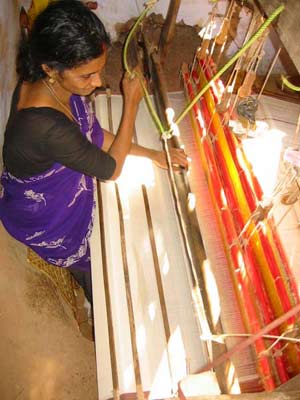
Handlooms - Why are they special?
 Handloomed sarees are made entirely by hand. It takes the efforts of two or three people 3 to 10 days to weave the average sari. Looms are generally amazingly simple constructions of wooden beams, ropes and poles. Many cottage weavers sit in pit looms with the warp spanning the floor of the hut. Inside the pit is an earthen bench and a series of pedals operating the heddles, and a take up beam for the woven cloth. More complicated patterning is done with the aid of jacquard machines suspended from top or supplementary floating heddles for creating small ornaments - called "bhutties" when they are in the field. Often times two or three people sit at the bench, each side person working on the border and bhutties and the middle person operating the pedals and beater.
Most handloom production occurs in private homes, where the entire family is engaged in some aspect of weaving, whether it be dying, tying up the loom, weaving or spinning threads. Many varieties of sari are woven with threads that are also handspun. This is called "Khadi" and means "homespun". This gives a rich texture and finish to the cloth, which is delightfully soft and supple.
The handloom tradition in India is complex and ever changing. Many regions are known for producing a certain type of sari, and that is how most sarees get their names, from the place they are woven. Fashion however has thrown a monkey wrench into this system, as popular regional styles end up being copied by weaving centers in other states. So it is possible to get a Bengal Baluchari woven with highly mercerised Madurai type cotton, woven, maybe in Bangalore. From the ornament one would want to call it a Baluchari - a sari prized for it's delicate pictorial ornament depicting scenes from religious epics, from the thread one might be tempted to call it something else.
In developing this website I've often been at a loss of what exactly to call many of the pieces I find. Shopkeepers generally have no idea what they are selling! More traditional weaves are easier to identify, especially the kind that are plainer - not oft to be draped on Bollywood starlets and causing national demand. These types of classic handlooms survive in regional fashion tastes. It's great to see how local women still wear locally produced traditional sarees. Women living in villages follow style tradition more than city dwellers, but this is unfortunately changing because of the allure of cheap and easy care polyester sarees. In Calcutta, however, every second woman was sporting a cotton Bengali handloom of some kind. South Indian women wear more regional cotton textiles than in the north.
Some sarees can only be made where they originate, because of the qualities of locally grown fiber, climate, and skilled labor - it is often impossible to duplicate those in other areas. For example the Balarampuram sari is so unique in its finish and hand because the extremely temperate coastal climate of Kerala promotes a super smooth finish when spinning the thread. Many styles have died out with the people who knew how to produce them. In the mid 19th century cotton thread so fine that if you could barely see it was woven into the finest dhakka muslins and exported all over the world.
Visit some weaving centers on the textile tour of India.
|


